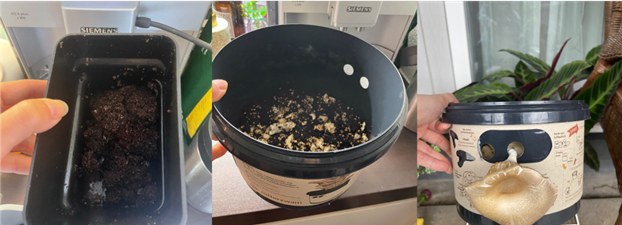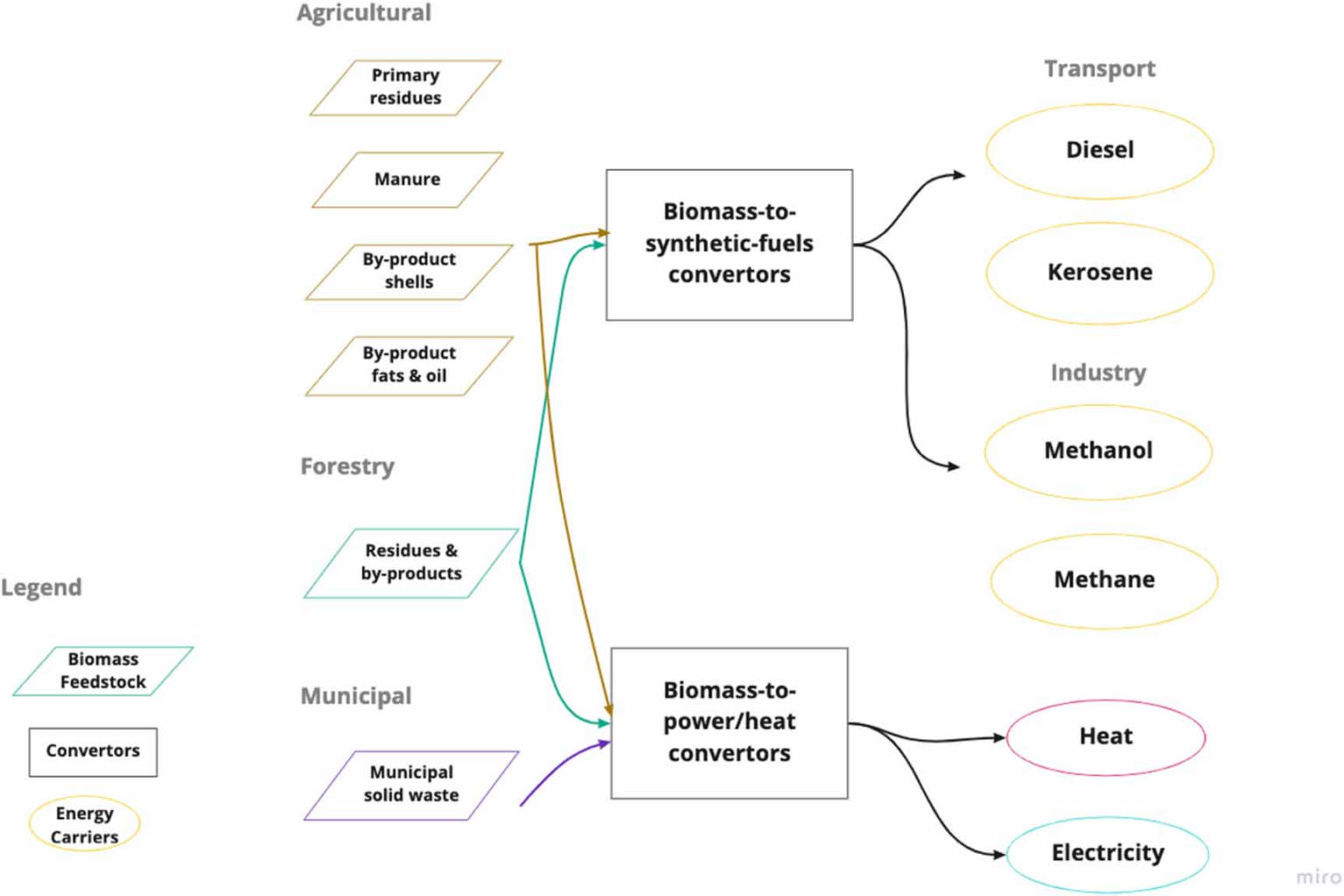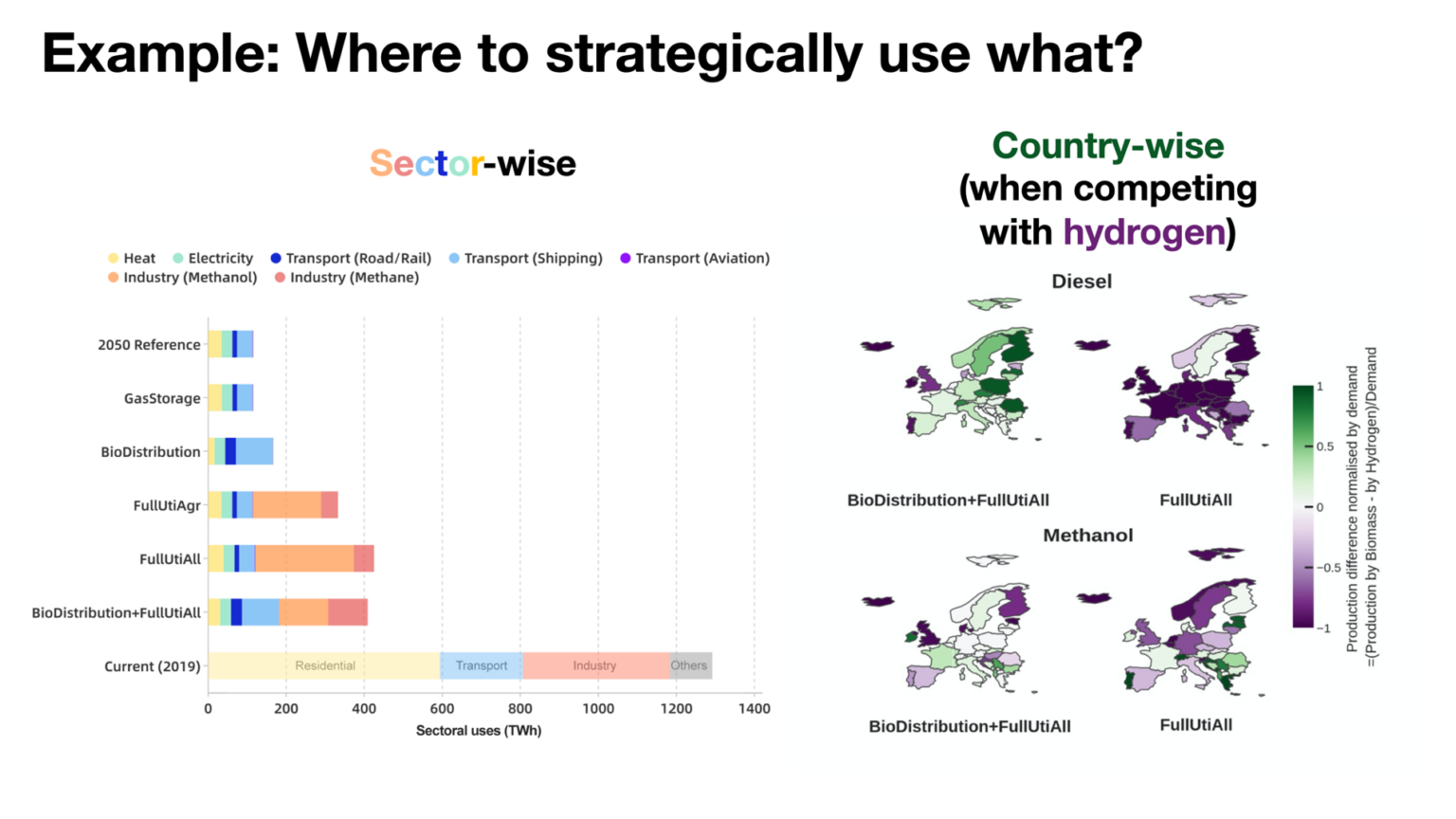
Land-free bioenergy for a carbon-neutral Europe –why, what, how?
On 20.06.2023 by Fei WuBy Fei Wu

Fei is a third-year PhD candidate at the Climate Policy group, D-USYS, ETH Zurich. She is currently visiting the Faculty of Technology, Policy and Management at TU Delft. Her research focuses on modelling the future role of sustainable bioenergy in Europe. She bridges the energy and food systems by applying both Calliope and SOLm models.
Navigating the complexities of bioenergy, its potential for carbon neutrality, and its conflicts with land, food, and feed resources is a pressing issue. What if we could circumvent these issues and focus solely on land-free bioenergy, similar to growing mushrooms on waste coffee grounds for a delicious dish? Waste and byproducts can generate valuable bioenergy, playing strategic roles in a future sustainable energy system. This blog post presents key findings from our latest research papers, providing insights into the strategic applications of land-free bioenergy and its policy implications. Join us in exploring the ‘why,’ ‘what’, and ‘how’ of deploying land-free bioenergy effectively in the quest for carbon neutrality.
Why ancillary bioenergy?
Bioenergy offers numerous advantages in achieving a carbon-neutral, fully renewable energy system, including power grid balancing, industry decarbonization, and delivering negative emissions. However, this substantial demand for bioenergy could result in significant land usage and potential clashes with food and feed production, particularly if we primarily use dedicated biomass crops like maize or miscanthus for energy generation. Could there be an alternative approach that eliminates these land/food/feed conflicts while still providing a less contentious source of bioenergy?
Indeed! There’s significant potential for deriving bioenergy from waste and byproducts, eliminating the need for dedicated land use. For instance, our research revealed that fish fats from Norway alone could cater to about 10% of Switzerland’s annual energy consumption (~50GWh). Beyond fish fats, several other “ancillary bioenergy” feedstocks exist – they are high in energy density, and don’t require land use, but are currently underutilized or overlooked in future energy system studies. We use the term “ancillary bioenergy” to denote the untapped bioenergy potential hidden in municipal, agricultural, and forestry residues, by-products, and co-products (see Figure 1), often neglected or deemed economically insignificant.
Using ancillary bioenergy could be a double boon: it reduces land-use concerns while fostering a circular economy. But questions linger: how much energy can we expect from these niche feedstocks in the future? What’s the most strategic way to employ ancillary bioenergy? How can it be effectively integrated into a carbon-neutral energy system, and what are the policy implications?
We answer these questions in our latest modeling study by exploring optimal uses of “ancillary bioenergy” that don’t conflict with land/food/feed needs. We find that while ancillary bioenergy’s future potential in Europe is limited (~30% of current bioenergy consumption), it can serve strategic niches if used wisely. This blog dives into the most strategic applications of ancillary bioenergy and its policy implications.

Figure 1. Examples of ancillary biomass feedstocks, conversion pathways, and corresponding bioenergy products (Fei Wu et al. 2023).
What are the strategic uses of ancillary bioenergy?
The strategic uses of ancillary bioenergy point out where (country or sector) and when (additional infrastructure) to use what (bioenergy or hydrogen), as illustrated in Figure 2. To assess this question, we used the energy system cost optimization model (Calliope) to deploy different utilization rates of bioenergy and/or enable additional bioenergy infrastructure to investigate the strategic uses of ancillary bioenergy biomass (Figure 2; See the caption for reference to the meaning of scenario names).

Figure 2. Strategic uses of ancillary bioenergy under different circumstances (‘2050 Reference’ is the 2050 baseline scenario when bioenergy is used optimally and where no additional infrastructure is available; ‘GasStorage’ has additional methane storage infrastructure; ‘BioDistribution’ has an additional transport network of distribution biofuels; ‘FullUtiAll’ fully utilizes all ancillary bioenergy; ‘Current (2019)’ refers to the European bioenergy end uses in 2019. Adapted from Fei Wu et al. 2023).
Sector-wise, our optimization results suggest different future uses for ancillary bioenergy compared to the current sectoral demand in Europe. For instance, residential heating is the major use of bioenergy right now, yet it is no longer a strategic use of ancillary bioenergy because there will be cheaper alternatives like heat pumps (i.e., See the yellow ‘Heat’ bit among all bars/scenarios in Figure 2). In all scenarios, ancillary bioenergy is more attractive for decarbonizing transport, especially marine shipping, in a fossil-free and carbon-neutral European energy system. This is mainly because marine shipping is not considered to be electrified until 2050, so it relies on synthetic fuels from biomass or hydrogen.
Furthermore, enhanced bioenergy infrastructure can greatly increase bioenergy use, particularly through an established biofuel distribution network (Refer to ‘BioDistribution’ in Figure 2). This network empowers nations to transfer surplus biofuels to other countries to meet their domestic demand. Consequently, countries with scarce or abundant biofuels can import additional or more affordable ones, bypassing reliance on their own production. Alongside fully exploiting all ancillary bioenergy, the biofuel distribution network can also aid in further decarbonizing industry and transport sectors by substituting hydrogen-based synthetic fuels in part. As a result, variations in utilization rates and the extent of available infrastructure coalesce to modify the optimal sectoral application of ancillary bioenergy.
Our modeling outcomes also provide insights into country-specific scenarios where using ancillary bioenergy surpasses hydrogen usage. In a carbon-free energy framework, hydrogen and bioenergy pose significant alternatives for creating synthetic fuels. Thus, it’s essential to establish which method is better suited for which fuels in specific countries. Bioenergy gains competitiveness for manufacturing synthetic diesel and methanol only if a biofuel distribution network exists. As illustrated in Figure 2, a predominance of green countries suggests bioenergy’s superior competitiveness, whereas purple indicates a preference for hydrogen. However, coastal European countries like the UK, Ireland, Iceland, and Portugal consistently favor hydrogen due to their abundant wind power, resulting in lower-cost synthetic fuel production from hydrogen as opposed to biofuels.
How to interpret the policy implications?
This research provides crucial perspectives on EU bioenergy policy, which anticipates a vital role for bioenergy but must navigate potential conflicts with land and food supply. Importantly, we discovered that ancillary bioenergy, which doesn’t require land, could play a key role in reducing carbon emissions in transport and industry, despite its limited potential by 2050.
In certain European countries, notably coastal ones like the UK and Ireland, hydrogen is a more competitive source for synthetic fuels than biomass. Interestingly, these countries currently have the highest biomass subsidy rates in Europe, above 30% in 2017. Further bioenergy subsidies may not be the best economic strategy in the long term when compared to hydrogen.
The interplay between different strategic uses of ancillary bioenergy reveals both synergies and trade-offs, which could guide a more harmonized European bioenergy strategy. For more in-depth discussions on the relationship between energy, land, and carbon in ancillary bioenergy use, check out the final section of our open-access paper.
This project has received funding from the European Union’s Horizon 2020 research and innovation programme under the Marie Sklodowska-Curie (MSC) grant agreement No 847585.
Cover image : Own photos of growing oyster mushrooms from waste coffee grounds at home.
Keep up with the Energy Blog @ ETH Zurich on Twitter @eth_energy_blog.
Suggested citation: Fei Wu. “Land-free bioenergy for a carbon-neutral Europe-why, what, how?”, Energy Blog @ ETH Zurich, ETH Zurich, June 20, 2023, https://blogt.ethz.ch/energy/land-free-bioenergy
If you are part of ETH Zurich, we invite you to contribute with your findings and your opinions to make this space a dynamic and relevant outlet for energy insights and debates. Find out how you can contribute and contact the editorial team here to pitch an article idea!
Authors
-
Fei Wu -
